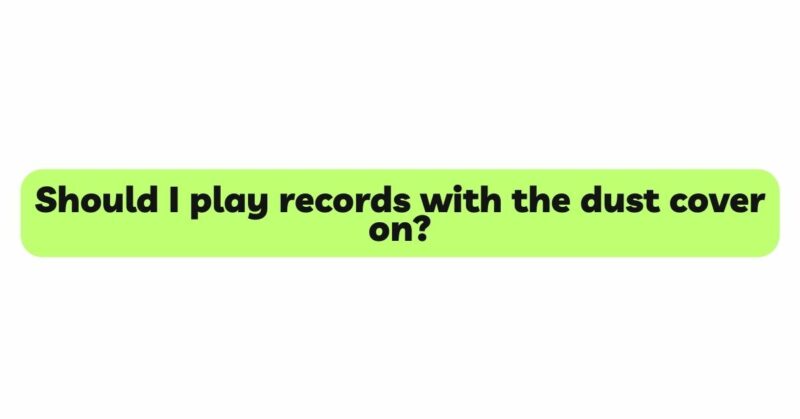Vinyl records have seen a remarkable resurgence in recent years, with audiophiles and music enthusiasts embracing the analog experience for its warm sound, tactile engagement, and nostalgic charm. As vinyl continues to captivate a new generation, debates about best practices and optimal playback methods have emerged among audiophiles. One topic that frequently sparks controversy is whether to play records with the dust cover on or off. In this article, we will delve into the arguments from both sides of the discussion and explore the potential impact of using the dust cover during vinyl playback.
The Purpose of the Dust Cover
The dust cover, often made of transparent acrylic, polycarbonate, or glass, serves as a protective lid for the turntable. Its primary purposes are as follows:
- Dust and Contaminant Protection: The dust cover acts as a barrier, shielding the turntable’s sensitive components, tonearm, and vinyl records from dust, dirt, and other airborne particles. This protection helps maintain the cleanliness of the stylus and record surface, ultimately preserving sound quality.
- Physical Protection: The cover also provides a physical barrier against accidental damage. It prevents objects from falling onto the turntable, potentially causing harm to the stylus, tonearm, or vinyl.
- Aesthetic Enhancement: In addition to its protective function, the dust cover can contribute to the overall aesthetic appeal of the turntable setup. Many covers are elegantly designed, adding to the visual experience of vinyl playback.
Arguments for Playing with the Dust Cover On
- Dust and Contaminant Prevention: One of the most compelling reasons to play records with the dust cover on is the assurance of maintaining a clean environment for the turntable. Vinyl records are susceptible to attracting dust and particles during playback, which can lead to pops, crackles, and other unwanted noises. By keeping the cover on during playback, you minimize the risk of dust settling onto the record surface and, consequently, reduce the need for frequent cleaning.
- Protection against Accidental Damage: Leaving the dust cover on ensures the safety of your turntable and vinyl records. Accidental spills, knocks, or objects inadvertently falling on the turntable are less likely to cause harm when the cover is closed. This provides peace of mind, especially in busy or crowded living spaces.
- Minimizing Environmental Disturbances: The dust cover can also act as a barrier against external disturbances, such as air currents or vibrations from nearby speakers or foot traffic. Keeping the cover closed can create a quieter, more controlled listening environment, potentially enhancing the audio experience.
Arguments for Playing with the Dust Cover Off
- Audio Fidelity: One of the primary arguments against using the dust cover during playback is the potential impact on sound quality. Audiophiles who prefer to play records with the cover off argue that the cover can resonate with sound waves, leading to vibrations that may compromise audio fidelity. They believe that removing the cover allows the sound to flow more freely, resulting in a more natural and transparent listening experience.
- Heat Dissipation: Some audiophiles advocate playing records with the cover off to improve heat dissipation. Extended playback sessions can generate heat within the turntable’s components, and a closed cover may inhibit proper ventilation. By removing the cover, you allow better air circulation, which can help maintain the optimal operating temperature of the turntable.
- Convenience and Engagement: Leaving the dust cover off can make the vinyl playback process more immediate and engaging. It eliminates the need to open and close the cover each time you want to play a record, allowing for a more seamless and immersive experience.
- Static Buildup Prevention: A closed dust cover can sometimes create static electricity, especially if made of certain materials like acrylic. Static buildup may lead to the attraction of dust particles to the record surface, undermining some of the dust protection benefits.
Finding a Balance: The Middle Ground
The debate surrounding the use of the dust cover during vinyl playback is not black and white. Many vinyl enthusiasts find a middle ground that strikes a balance between protection and audio quality. One common compromise involves using the dust cover when the turntable is not in use or during long periods of inactivity. This approach ensures that the turntable and records are safeguarded from dust and contaminants when not in use. However, during active playback sessions, the cover is removed to allow for better sound quality and reduced interference.
Additionally, some turntable models are designed to accommodate the dust cover in various configurations, allowing users to partially remove or prop up the cover during playback. This setup can help strike a balance between dust protection and sonic performance.
Conclusion
In the end, the decision of whether to play records with the dust cover on or off largely depends on personal preferences and circumstances. Both options have their merits and trade-offs, and there is no definitive answer that applies to every situation. Audiophiles should consider the environmental conditions, their turntable setup, and their priorities regarding sound quality and protection when making their choice.
Ultimately, the magic of vinyl lies in the enjoyment of music and the unique connection it fosters between the listener and the artist’s work. Regardless of whether you choose to keep the dust cover on or off, the joy of vinyl playback remains a timeless and cherished experience for all those who appreciate the beauty of analog music.


